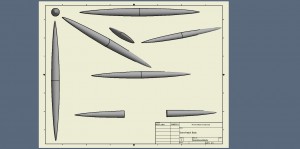(P150) Sears-Haack Body: Inventor Model
by PhoenixGames on Aug.20, 2014, under Art and Designs, Concepts, Inventions
The Sears-Haack body is the shape which has the lowest possible wave drag while travelling at supersonic speeds, and is therefor the optimum shape for a vehicle operating at these speeds.
At low speeds, the majority of drag on a flying vehicle is induced and parasitic drag. At Transonic and Supersonic speeds the effects of wave drag become much more prevalent. This affects the shape of the wings (causing the optimal shape to become highly swept, or delta shaped) and affects the fueselage as well, resulting in the Sears-Haack.
For an Ekranoplan travelling at high speed, as much of the hull as possible should match this shape.
The equation to calculate the profile of a Sears Haack body can be found in the paper “Bodies having Minimum Pressure Drag in Supersonic Flow – Investigating Nonlinear Effects” by Karthik Palaniappan and Antony Jameson.
The equation (in mathematical form) is:
![y(x) = sqrt{ underline{{16V}} / {3 PI^2} }[4x(1-x)]^{3/4} y(x) = sqrt{ underline{{16V}} / {3 PI^2} }[4x(1-x)]^{3/4}](http://phoenixgamedevelopment.com/blog/wp-content/plugins/wpmathpub/phpmathpublisher/img/math_980.5_c11275202a22fc29414dacbc9e734ac3.png)
where V is the enclosed Volume.
In a plotting tool, the equation can be written as:
y(x) = sqrt(((16*V )/(3*pi^2))*((4*x)*(1-x))^3/4
again with V being the enclosed volume.
After much research and work with mathematical equations I have manged to produce a model of this shape in AutoDesk Inventor. As it turns out, the Equation Curve Editor in Inventor 2013 has a bug, which made modelling this equation more difficult. This is to do with the tmin and tmax ranges of parametric equations. Normally, the correct values are 0 and 1, but this can cause bugs in some cases, such as when the equation used has decimal exponential powers, (such as the 3/4 power in the Sears-Haack Equation). This can be fixed by changing the tmin and tmax range to slightly greater than 0, and slightly less than one (for example 0.0001 and 0.999999). This bug has apparently been fixed in Inventor 2015.
The next step in the Ekranoplan concept is to model several wing shapes and attach them to the Sears-Haack body, then conduct a virtual wind tunnel analysis in OpenFOAM.
